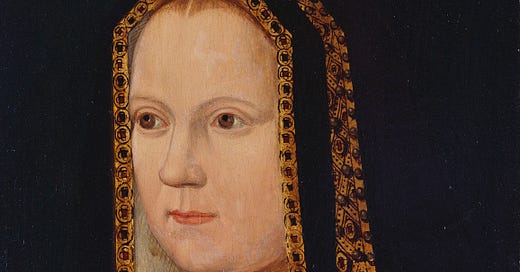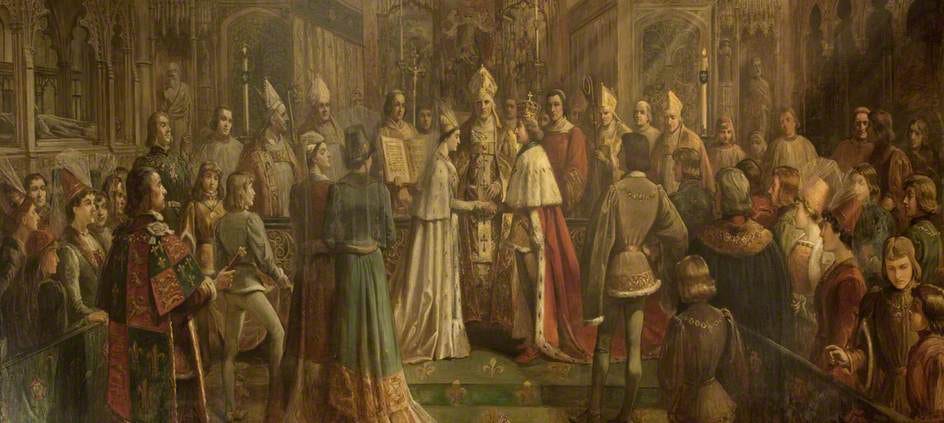The Coronation of Elizabeth of York
On 25 November 1487, Elizabeth of York was crowned queen of England in a glittering ceremony within Westminster Abbey.
1487 had been a tough year for the fledgling Tudor Dynasty, a year of revolt in which the king, Henry VII, had been forced to defend the crown, one he himself had usurped two years earlier, in battle. His forces had been victorious at the Battle of Stoke Field, defeating an army nominally led by a child it was later revealed was Lambert Simnel, supposedly impersonating Edward, Earl of Warwick, the senior Yorkist claimant.
This, however, had proven an anxious episode for the Tudor regime, and on a different day, perhaps inclement weather or a timely defection could have swung the day the other way, as had happened throughout the Wars of the Roses.
But Henry had emerged victorious. The first significant challenge to his reign had been overcome, his enemies scattered if not killed, and the crown remaining atop his head. He did, however, hear the message loud and clear. It was time to have his popular wife, the mother of his heir and through whom many considered his claim to kingship rested, crowned.
When Henry had become king, he very quickly made sure he himself was crowned, taking his seat upon the throne in Westminster Abbey on 30 October 1485. This was before he had married Elizabeth, and before even, his first parliament assembled. Henry ensured there was no doubt whatsoever that he owed his crown to anyone other than God him (or her?) self.
When he did marry Elizabeth in January 1486, Henry did not have her crowned as perhaps would be expected, though there are a few payment records for equipment and cloth for ‘the queen’s coronation’. It seems that any plans for a coronation at this point were quickly rendered impractical when it became clear the queen was with child. She would become the first uncrowned queen of England to bear a royal heir since 1066.
At the end of the year, her baby boy Arthur being safely delivered in September, there are again references to the queen’s coronation in payment records, but this time it seems knowledge of a growing rebellion in Ireland, which would lead to an invasion of Tudor England in the summer of 1487, again pushed back plans for Elizabeth to be crowned.
But having now overcome his enemies, Henry now sought to finally have Elizabeth crowned. That difficult summer, husband and wife had spent much time together in Kenilworth Castle in the Midlands, Henry temporarily leaving Elizabeth’s side in June to meet the rebels in battle. In August, they visited the wonderful Oxburgh Hall in Norfolk, and around this time the decision was made by Henry to celebrate his wife.
Now, one chronicler noted he decided to push ahead with the coronation out of the ‘perfect love and sincere affection that he bore his queen’, and this may be true in some regard. Henry and Elizabeth do seem to have worked as a couple, despite the political aspect of their union. But it was also a pragmatic and strategic move designed to appeal to any Yorkist-leaning supporters among his nobility and gentry, lest they become disenfranchised in future and go rogue.
With his nobility already in London for parliament, the stirring spectacle of a coronation was a convenient opportunity for Henry to very publicly reassert his emergent regime's authority after two failed rebellions within a year, and to remind his subjects, loyal or otherwise, just whose grip remained on the crown. It also allowed him the opportunity to very publicly celebrate and honour the wife who had given him everything he wanted. Little expense was to be spared.
Henry and Elizabeth were in Warwick as late as 27 October when they began their journey back to London together, passing through St Albans on the way. On 3 November, the king made his triumphant entry into London, once more serenaded as a conquering hero who had overcome his foes, before the royal family decamped to Greenwich to prepare for the big occasion.
The festivities started in earnest on 23 November when Elizabeth, 'royally apparelled, and accompanied with my Lady the King’s Mother', Margaret Beaufort, was conveyed upstream from her royal apartments.
For the queen’s journey by water from Greenwich, she was surrounded by an ostentatious water pageant that spanned the breadth of the Thames, with 'barges freshly furnished with banners and streamers of silk richly beseen’. One striking boat, known as the Bachelers Barge, outshone all others for it supported 'a great red Dragon spouting flames of fire' into the river, with the air filled by joyful music courtesy of trumpets, clarions and minstrels, arranged for Elizabeth’s 'sport and pleasure'. Those watching the remarkable spectacle from either bank must surely have been astounded as the barges sailed past one-by-one, an exhilarating blend of sound and colour emanating from the water before them.
The river pageant terminated at Tower Wharf on the northern bank of the crowded Thames, where Elizabeth was ceremoniously guided into the heart of the Tower of London to her awaiting husband. It was said that he personally welcomed his queen 'in such manner and form’ that it proved 'a very good sight, and right joyous and comfortable to behold’. Although this wouldn't have been the first time Elizabeth had visited the fortress since her brothers' disappearance during the summer of 1483, the boys remembered as the Princes in the Tower, one does wonder whether she paid her missing siblings any thought two nights before a coronation she would never have required had their whereabouts been known.
The following morning, the queen departed the Tower for Westminster dressed in a kirtle of white cloth of gold covered with an ermine mantle, fastened by a gold and silk lace embellished with tassels to protect her from the autumn chill. Her 'fair yellow hair' hung loosely down her back, and atop her head sat a golden circlet richly garnished with precious stones. With her younger sister Cecily bearing her train, Elizabeth was carried through the freshly cleaned and richly decorated streets of London in a litter furnished with large feather pillows and covered with more cloth of gold. All along the route, she was greeted with the sight of children dressed as angels and virgins, who sung sweet songs as she passed.
Riding near the royal litter in positions of honour were Henry VII’s most trusted men, figures like the king’s uncle Jasper Tudor, Duke of Bedford, and the earls of Oxford and Derby, each of whom had been instrumental in propelling the king to his throne. Another prominent noble accompanying the procession was the duke of Suffolk, who presumably was careful to conceal any grief he felt over the premature death of his traitor son, the earl of Lincoln, a few months previous. In the chariot behind followed Elizabeth’s sister Cecily and her maternal aunt Katherine Woodville, who was also her aunt-by-marriage since she was married to Jasper Tudor, as well as the duchesses of Norfolk and Suffolk.
It is also intriguing to note that amongst the procession were six henchmen guarding the queen at all times, each riding a palfrey covered with cloth of gold embroidered with white roses and suns, symbols closely associated with Elizabeth’s father Edward IV and the House of York in general. This would not have been sanctioned without the consent of King Henry, keen to brand his dynasty with the increasingly ubiquitous Tudor Rose, but demonstrates the wily monarch was willing to encourage the Londoners’ known affection for the Yorkists, in the hope it would generate support for his own line through the agency of his beloved wife.
The coronation itself took place the following morning, 25 November, the feast day of St Katherine, the virgin martyr who was the patron saint of royal ladies. Elizabeth was dressed in another kirtle covered with ermine mantle of purple velvet, her head topped with a golden circlet covered in pearls and other precious gems that was likely a gift from Henry.
As she proceeded into the Abbey, Elizabeth walked along a striped cloth, and after she passed, crowds of people surged forward to cut part of the material as a keepsake. Unfortunately, they proved too enthusiastic and at least a few were killed in the crush that occurred.
Once inside, the queen was led through the nave by the bishops of Ely and Winchester, until she was met by the archbishop of Canterbury, and one of her husband’s closest confidantes, John Morton. Once the usual religious rituals had been observed, Elizabeth was anointed with holy oil and taking her seat upon her throne, was handed a sceptre and rod. Finally, ‘with great solemnity’, she was crowned. It may even have been the same crown placed upon her mother’s head twenty-two years earlier.
Observing matters covertly from a 'goodly stage covered and well besene with cloth of Arras' was the king, his mother Margaret Beaufort, and the teenage Lady Margaret Pole. Henry was content to stay out of sight all day, and ensure that his wife was centre of attention.
Once the ceremony was concluded, with Mass being heard and Elizabeth presenting her crown at the shrine of St Edward, she was escorted to the adjacent palace’s Great Hall, where a sumptuous feast was held in her honour. Seated upon a raised platform, and probably beneath a canopy of some kind bearing her arms with her ladies-in-waiting attending upon her every need, Elizabeth held court.
Twenty-four dishes were offered to the queen for the first course alone, featuring things like a wheat porridge with venison, a meat broth, minced venison with spices and dried fruits, pheasant, swan with spiced entrails, capons, eels in bread sauce, pike and heron in sauces, and rabbit meat.
The second course featured another twenty-seven dishes, including beef and chicken broth, roasted peacock, and an array of pheasants, partridges, fish, rabbit, quails, venison, milk puddings, fritters, and a castle of jelly. Trumpeters and minstrels announced the arrival of each dish in their customary manner, and all was washed down with some hippocras, or spiced wine.
With her stomach full and her heart content, Elizabeth finally rose to retire to her chamber. As she did so, one chronicler remarked 'the Queen departed with God’s Blessing, and to the rejoicing of many a true Englishman’s heart'. She loved the people, and the people loved her.
Learn More
Much of the above is an abridged version of that which appears in my book Henry VII and the Tudor Pretenders: Simnel, Warbeck and Warwick, which was the first book to cover the full rebellions which plagued Henry VII’s reign. Please do check it out.









Elizabeth of York always feels so enigmatic but this captures my imagination, and with such detail!
She must have been a lovely lady.